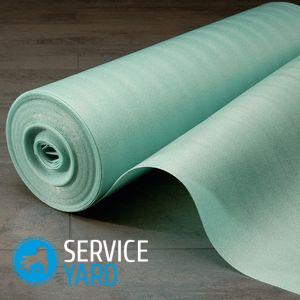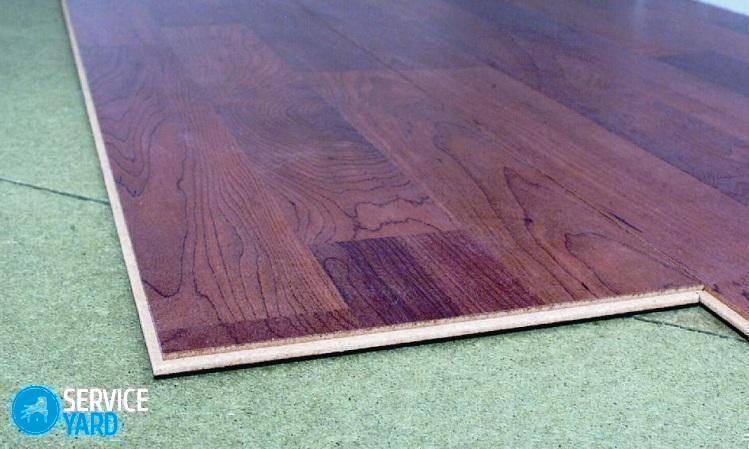What substrate to choose under the laminate on plywood?

Leveling the floor with the help of plywood has gained its demand due to its low cost, ease of installation, environmental friendliness. Such a floor is durable and quite durable. Most often, plywood is used as the basis for a laminate to level old wooden floors. Such a coating perfectly retains heat, which is especially appreciated in private homes. Leveling floors with plywood is quite easy, so this method of laying is popular today.
One way to level the floors is to lay the plywood on an old, wooden floor. This method is especially relevant if the floor has fallen into disrepair - it has dried up, large gaps have appeared, and it has become loose. Thanks to plywood, it is possible to level the floors for the subsequent laying of the laminate. In this article we will talk about which substrate to choose under the laminate on plywood and how to properly lay it.
to contents ↑Choosing the Right Material
To determine the choice of material, you should consider the entire classification. As a rule, plywood is made of tightly pressed layers, the amount of which is always odd. For example, for a thickness of 16 mm there are 11 of them.
Classes
All types of material are usually divided into three categories:
- FOF - the lowest level of moisture resistance. Suitable for living quarters.
- FC - the average level of moisture resistance. The glue is completely non-toxic, so the material is suitable for use in residential premises.
- FSF - has a high resistance to moisture. The layers stick together with toxic adhesives, so this version of plywood is completely unsuitable for use in residential premises.
Raw materials based
Also, this material is divided according to another feature - the wood used:
- Coniferous.
- Birch.
The first type is quite resistant to mold and fungi. However, it is better to use such plywood only in the roof, because glue together with resins can release some harmful substances.
Important! Thus, it is easy to understand that for interior finishing work it is best to use FC material from birch. For outdoor work, FS from birch is great.
Quality
Now let's look at FC plywood, which is usually divided into 4 groups:
- Without visible external flaws.
- There are inserts of knots and veneers.
- There are some flaws - numerous cracks and knots.
- There are a lot of cracks, knots, veneer upstairs - however, the quality of gluing is the same.
Important! This classification shows that among themselves all groups differ only in appearance. Based on this, it can be concluded that the answer to the question that should be chosen as the substrate for the plywood laminate is the quite logical answer: FC from birch trees of the third category, that is, the cheapest, because the fourth one may not be perfectly smooth, and the second and the first is quite expensive.
Among other things, there is a classification according to other parameters, for example, according to the content of formaldehydes. It does not make sense to consider it in detail, you just need to remember that when choosing a plywood brand, you need to know the FC-3U1Sh1 encoding.
to contents ↑Basic laying rules
To properly lay plywood on a wooden floor under a laminate, you need to know some rules:
- Plywood cannot be used for damp rooms where large temperature differences occur. This method is not recommended for use in buildings where there is high humidity. Also, it is not suitable for unheated rooms, sheds, baths, and bathrooms.
Important! To check the humidity in the room, lay polyethylene on the floor, press it tightly and leave it for several days. If condensation appears, then this method of laying will have to be abandoned.
- Before laying plywood, you should check the strength of the wooden floor - it should not bend along the logs. In the event that the lags are fragile, then first you need to repair them by lifting the flooring and checking them. Those logs that are rotten will have to be replaced. It is also necessary to work out all the lags with an antiseptic.
- Plywood sheets are laid in such a way that at one point no more than three joints meet. A distance of approximately 8 mm is required between the seams. Between the walls and plywood you need to leave a small gap of about 2 cm. Later, you can close these slots with skirting boards. Sheets are recommended to be numbered so as not to confuse their location during final assembly. In addition, it will not be superfluous if you draw a layout of plywood sheets.
Important! The thickness of the plywood sheet must be at least 12 mm. In that case, if the surface is quite smooth, then sheets of approximately 10 mm can be used in the work. Under the laminate, it will be better to use a flooring of at least 12 mm.
- The best solution would be to cut the plywood sheets into pieces of 60 cm squared. With this, you can avoid a large number of damper joints.
- Before laying plywood, clean the rough corner of chips, debris and dust. At the last stage of laying, it is necessary to treat the floor with a special primer. This procedure is also called priming.
- To properly lay plywood on a wooden floor under a laminate, the best option is to use self-tapping screws. They are fixed at the edges at a distance of 20 cm. An indent of 2 cm is made from the edges. The caps of self-tapping screws must be inset. Fasteners should exceed the thickness of the plywood sheet in two, or even three times. For example, for plywood 15 mm thick it is better to use self-tapping screws 45 mm.
- After laying, the plywood sheets should be properly sanded. To do this, use the appropriate tool - sandpaper or a grinding machine.
Styling features
Laminate is traditionally laid on a cement screed. However, technology has also often begun to be applied when the laminate is laid on plywood. At the same time, the laying technology does not change. In addition, this method has many advantages.
to contents ↑Important! In laying laminate has its own characteristics. Experienced specialists often advise to lay the laminate only on plywood. Especially if the flooring is wooden, then this method will be the most correct. The reason is that plywood flooring helps to achieve an almost perfect surface. In addition, the plywood is well-absorbed, which increases the life of the floor.
Floor preparation before laying
Before laying plywood, some preparatory work must be completed. First of all, you should clean the surface of dust, dirt, then eliminate bumps, cover all cracks.
In addition to strengthening with self-tapping screws, it is recommended to use glue. It can be bought at any hardware store. Ideally, if such glue is based on PVA, it fills the entire space under the plywood. This can be determined by tapping plywood - the sound should be uniform and deaf.
to contents ↑Important! It is impossible to lay plywood on a too curved floor - first you need to level the rough coating.
Ways of laying plywood on a wooden floor:
- The easiest way is laying plywood on a finished wooden floor.Having made preliminary preparation of the base, having made it leveling and cleaning, plywood can be safely screwed using screws.
- There is another way to level the floors when the plywood is laid on wooden logs. This method is relevant if the source floor has significant differences in height. And also if it is necessary to lay communications under the floor.
to contents ↑Important! This method is more time-consuming, requires certain skills and takes more time. However, it does make it possible to achieve a perfectly even floor.
Plywood laying technology
To properly place plywood on a wooden floor under a laminate:
- Need to lay from the center of the room.
- After the central part has been laid out, they start cutting the sheets along the edges of the room so that the plywood barely reaches the walls.
Important! Try to find the most optimal position for each sheet using numbering and a pre-drawn diagram.
- After the work done, it is necessary to remove the plywood and begin cleaning the floor surface.
- Then proceed to glossing over cracks and priming.
- After the surface has completely dried, you can begin laying plywood. During fastening, you should check the evenness of the installation - this can be done using a long rail.
- Logs are laid so that their surface is perfectly flat. This can be achieved with a level.
- Free recesses between the lags are filled with insulation.
- Communications should be laid before laying plywood.
- Sheets of plywood are cut into identical squares, with the expectation that the joints will lie exactly on the logs.
- After the plywood sheets are laid, they are fastened with screws at a distance of 15-20 cm, 2 cm back from the edges of the plywood.
to contents ↑Important! If irregularities are found, they are eliminated with the help of pieces of fiberboard, wooden substrates.
Pros and cons of leveling a wooden floor with plywood
With the help of plywood, it is possible to perfectly level the surface. If the work is carried out with accuracy, then as a result you can get a flat, insulated floor surface. Further, the floor can be covered with a laminate, because if you lay it on a curve, the shattered floor, then its appearance will be completely unattractive.
Today, laminate flooring has become very common. Its advantage is that such a decorative floor can be laid on almost any foundation, of course, subject to preparatory work. Even for owners of private houses with wooden floors, it is possible to qualitatively and inexpensively prepare the floors in order to properly lay the plywood on the wooden floor under the laminate. Let's take a closer look at the advantages and disadvantages of this method.
Benefits:
- Thanks to plywood, thermal and sound insulation is achieved.
- Good moisture resistance gives a guarantee for long service of a laminate.
- Easy installation.
- Minimum financial costs for the material.
- As a result, an even and stable base for a decorative coating is obtained.
Disadvantages:
- When leveling with plywood, the height of the floor increases. In rooms with low ceilings, this method is not recommended.
- Cannot be used in rooms with high humidity.
- Plywood and laminate are afraid of water, so this floor will require special care.
Stock footage
So, choosing a quality material and properly laying plywood on a wooden floor under the laminate, as a result - you will get a high-quality and durable flooring.
- How to choose a vacuum cleaner taking into account the characteristics of the house and coatings?
- What to look for when choosing a water delivery
- How to quickly create comfort at home - tips for housewives
- How to choose the perfect TV - useful tips
- What to look for when choosing blinds
- What should be running shoes?
- What useful things can you buy in a hardware store
- Iphone 11 pro max review
- Than iPhone is better than Android smartphones




